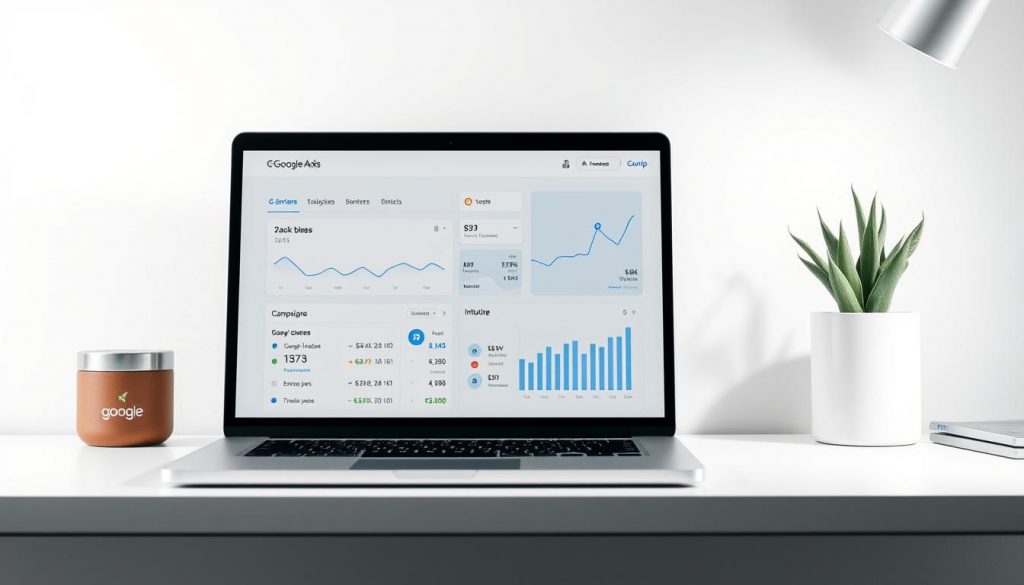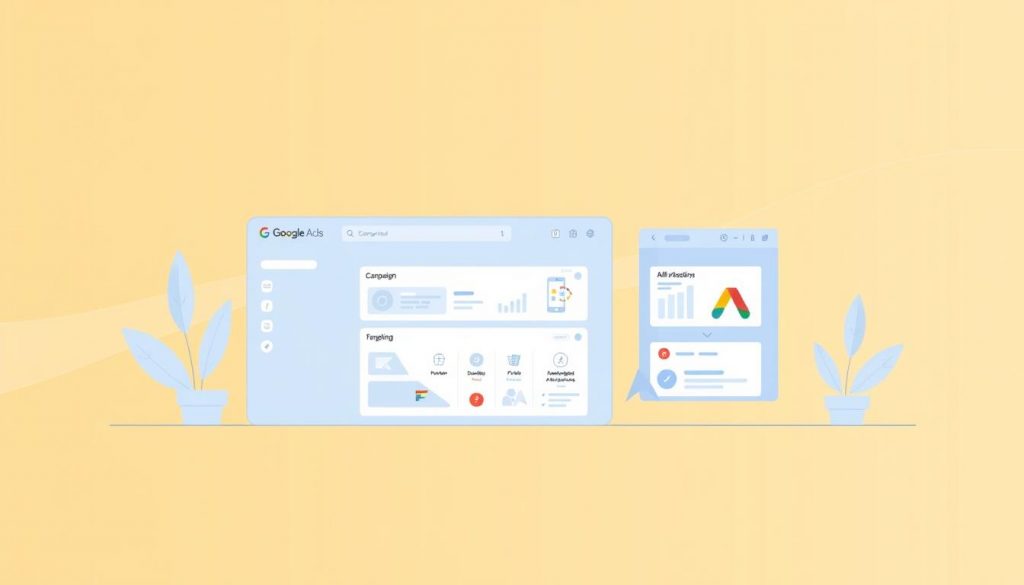We get it: stretching every dollar feels personal. As a team that helps owners grow, we have seen the stress of choosing the right advertising path. You want clear results, not guesses.
This guide shows a practical way to use pay-per-click tools and protect your spend. We focus on measurable outcomes. Every dollar must have a job and a defined result.
You’ll learn how ppc works today, why high-intent demand beats broad awareness on a tight budget, and how to build an account that scales after you prove conversions. We cover targeting, keywords, ad copy, and landing pages so you capture qualified leads.
We also explain tracking essentials—Analytics links, UTM tags, and conversion actions—so you can see what you pay for and ramp spend with confidence.
Key Takeaways
- Prioritize measurable outcomes over vanity metrics.
- Use high-intent search to get better leads on a low budget.
- Set up account structure and tracking before scaling spend.
- Protect budget with negative keywords and inventory controls.
- Start small, measure conversions, and then increase wisely.
Why Google Ads Can Work on a Small Budget
We recommend a tight, intent-driven approach when money matters most. Local search reaches people actively looking to buy. That means fewer wasted impressions and faster results.
High-intent searches beat broad awareness. Someone searching a specific need is closer to conversion. Targeted copy and a single focused landing page often produce better leads than a large, generic website.
Cost control is a major advantage over traditional channels. You set a daily spend, pause campaigns anytime, and limit delivery to zip codes or a 5–20 km radius. That reduces clicks from outside your service area.

Within 24–72 hours you’ll see clicks, cost, and conversions. Use that data to refine keywords, location, and ad copy. With proper conversion tracking, the account shows true cost per lead and helps you scale what works.
- Start with search and maps to capture ready customers.
- Keep campaigns tight: one service, one location, one offer.
- Use ppc controls to protect spend and improve ROAS.
Understanding How Google Ads Works for Small Businesses
Every search triggers an auction that decides which ad appears and what you pay. Ad Rank blends your bid with quality signals — relevance, expected impact, and landing page experience — to set position.
What you really pay per click depends on competitors, your quality score, and the auction outcome. With pay-per-click, you only pay when a user clicks. That makes tracking essential: clicks without conversions drain budget and hide the true cost of leads.

Where your ads can appear
Ads may show on search results, Maps, the Display network, apps, and YouTube. Each placement brings different traffic and intent.
How to prioritize placements
Start with search campaigns to capture explicit intent. Search gives clearer signals and tighter control of spend. Add Maps, Display, or video options only after search campaigns deliver consistent results.
“Better alignment between keywords, ad copy, and landing pages lowers costs and lifts conversions.”
- Use device, location, and schedule controls to focus limited budget on the best traffic.
- Name campaigns clearly to separate goals and networks in your account.
- Track search traffic separately to keep your data clean and decisions precise.
Set Up Your Google Ads Account the Right Way from Day One
We start with measurement and controls so your budget works hard from the first click. Get tracking in place, then open delivery. That order saves you wasted spend and messy data.
Link Analytics and Enable UTM Tracking
Create a clean ads account structure with clear names, then link Google Analytics to capture channel and campaign performance at the website level.
Add UTM parameters to every final URL. This unifies reporting across Analytics, your CRM, and the ads account so sessions and conversions map back to the ad.
Connect Your Business Profile
Connect your Google Business Profile so local assets—address, phone, and reviews—can appear in Search and Maps. Local visibility drives more qualified clicks; nearly half of local searchers use the map pack.
Turn Off Auto-Apply and Restrict Early Placements
Disable auto-apply recommendations. We review changes manually to protect tight budget control and quality.
Turn off Search Partners and Display during early testing. That limits junk clicks and keeps spend focused on high-intent Search traffic.
- Set up conversion actions (calls, forms, purchases) and verify they fire before scaling budget.
- Build shared negative keyword lists and attach them to campaigns pre-launch.
- Use least-privilege user access and set budget caps with email alerts for anomalies.
Define Goals, Conversions, and What “Success” Looks Like
Begin with a single, trackable goal so each dollar you spend ties to a clear outcome. We set one objective per campaign to keep optimization focused and data clean.
Pick a primary goal: phone calls, form submissions, or online sales. Align one campaign with that goal and send traffic to a dedicated landing page on your website.
Set up conversion tracking and choose what to optimize
Enable google ads conversion tracking for calls from ads, calls from your site, forms, and purchases. Test each path end-to-end so the account records real results.
For calls, use a duration threshold (example: 180 seconds) to count meaningful conversations as conversions. Integrate tracking with your CRM so you can grade lead quality and close rates.
Know your target cost per lead
Define target cost per lead using average order value and close rate. That single number guides bids, budgets, and scaling decisions. If CPL exceeds the target, pause and refine.
Practical rules to keep reporting useful
- Mark primary conversion actions for bidding and keep secondary actions out of automated goals.
- Use clear names like Lead_Form_Submit and Call_180s+ to avoid report confusion.
- Review spend, conversion volume, conversion rate, and CPL weekly. Adjust campaign budgets and keywords based on real performance.
“Know the one number that decides scale: your target cost per lead.”
Google Ads for small businesses
One service, one area: that focus turns sparse data into clear signals you can act on. Concentrate budget so you learn which keywords, ad copy, and landing pages truly convert.
Start with Search-only. Run a single, tightly scoped campaign to control queries and measure performance. Avoid Performance Max at launch—it needs volume to show reliable results.
Use single-intent ad groups and standard naming like Search_Dallas_Plumbing_Exact. Keep budgets modest and raise them only after two to four weeks of stable leads and target cost per lead.
| Step | Action | Goal |
|---|---|---|
| 1 | Launch Search-only campaign for one service | Capture high-intent leads |
| 2 | Use single-intent ad groups & shared negatives | Improve relevance and CPL |
| 3 | Document expansion gates by area | Scale only when profitable |
- Favor deep data: 100 clicks on one ad beats 100 clicks on 100 ads.
- Standardize names and track performance at the campaign level.
- Resist platform defaults; stick to the plan until results prove the approach.
Location Targeting That Cuts Waste and Lifts Conversion Rates
Use presence-based targeting to keep your ads visible only to people in your service area. This reduces wasted clicks and raises the chance that a caller is a real prospect.
Set Location options to Presence — choose “People in or regularly in your included locations” rather than interest-based reach. Exclude non-service ZIP codes and nearby cities you can’t serve. That protects a tight budget and improves lead quality.
Radius vs. ZIP code targeting
Pick radius targeting for flexible coverage around a central place. Use ZIP codes when you need precise control over which areas see the ad.
Ad scheduling and staffing
Run campaigns only during times your team can answer. Keep call assets live during working hours to avoid missed calls and poor experiences.
- Use separate campaigns for different geographies to match bids and budgets.
- Review location reports weekly and shift spend to top-performing ZIPs.
- Adjust mobile bids if most customers call from phones at certain times.
Keyword Strategy on a Budget: Research, Match Types, and Negatives
Start by choosing tight keyword groups that match real purchase intent. This keeps the account focused and prevents early waste. Begin with exact and phrase match to control who sees your ads.
Build negative keyword lists before launch. Add job, free, DIY, training, and competitor brand negatives. Attach shared negatives across campaigns so the same unwanted searches never drain budget.
Use local modifiers like city names, neighborhoods, and “near me” to filter casual searches. That improves relevance and raises the chance of quality leads.
Run keyword research with Keyword Planner to estimate volume and cost. Prioritize high-intent searches and move converting search terms into exact matches.
Test Dynamic Keyword Insertion only after you have tight match types and robust negatives. Monitor impression share and top-of-page rate on priority terms to guide any bid or budget changes.
- Keep ad groups tight: fewer keywords, clearer message.
- Document winning keywords and losing terms for future research.
Write Ads and Assets That Win Clicks and Filter Out Junk Leads
Strong, local-focused copy can stop irrelevant traffic and raise conversion rates quickly. Use Responsive Search Ads (RSAs) to mirror search terms and include the city or neighborhood in headlines. Pin a clear headline with price or a qualifier to reduce low-quality clicks.
One case saw a 27% lift in qualified B2B leads after adding a price point to the headline. That simple change signals fit and saves budget.
Responsive Search Ads that mirror search intent and location
Write headlines that reflect the user query and local location. Mix pinned and flexible headlines to keep the message stable while testing variations.
Use pricing, offers, and qualifiers to improve lead quality
Include “from” pricing, service limits, or target customer types in headlines. This filters out unqualified prospects and improves lead quality.
Ad assets that matter locally: Call, Location, Sitelinks, Reviews
Activate Call and Location assets so customers can contact you directly. Add sitelinks to pricing, emergency service, and financing pages on your website.
- Show star ratings and review snippets to build trust fast.
- Test offers like same-day service or free estimates without cutting margin.
- Use countdowns and path fields (e.g., /Austin/Service) to boost relevance.
“Align ad copy with the landing page to keep visitors engaged and reduce bounce.”
Smart Bidding and Budgeting for Tight-Wallet Accounts
We start with low daily spend and clear conversion goals. Test the full funnel on a modest budget. Scale only after consistent conversions at your target cost.
Daily budget testing: start modest, scale after real conversions
Begin with a modest daily budget to validate the conversion flow. Watch clicks, cost, and conversion quality. Increase budgets only when results meet your CPL target.
Manual CPC vs. Maximize Conversions with a CPC cap
We recommend Manual CPC initially to keep control of bids. Move to Maximize Conversions later and use a portfolio strategy with a max CPC cap. That prevents rare spikes that destroy margins.
Bid adjustments informed by search term and location data
Shift bids by location, device, and time of day. Use search term performance to raise bids on proven keywords and lower spend where conversion rates lag.
| Metric | Start | Scale Trigger | Guardrail |
|---|---|---|---|
| Daily budget | $10–$25 | 20 conversions ≤ target CPL | Cap daily spend |
| Strategy | manual cpc | portfolio maximize | max CPC cap |
| Adjustment cadence | weekly | after stable data | avoid frequent shifts |
“Keep learning periods stable—don’t reset optimization with frequent bid changes.”
Measure, Improve, and Protect Your Ad Spend
Turn raw data into action: review reports weekly, add negatives, and move winning queries into exact or phrase match. That keeps wasted clicks low and improves overall performance.
Run structured A/B tests on ads and landing pages. Test one variable at a time: headline, offer, or form field. Use experiments to compare bidding or location changes safely before broad rollout.
Call tracking and conversion quality
Enable call tracking with forwarding and set a 180-second threshold to count meaningful conversations as conversions. This separates true leads from short, unqualified calls.
Integrate the account with your CRM
Connect your google ads account to your CRM so campaign, keyword, and ad map to actual sales stages. Track outcomes, not just volume, to see which campaigns drive revenue.
| Action | Metric | Cadence |
|---|---|---|
| Search terms review | New negatives / winning queries | Weekly |
| A/B tests | CTR, conversion rate, CPL | 4–8 weeks per test |
| Call threshold & CRM mapping | Qualified conversions, lead value | Ongoing |
“The best way to protect tight budgets is proactive management: frequent reports, disciplined negative expansion, and clear change logs.”
- Use dashboards that combine website and ads data for a single source of truth.
- Create alerts to catch sudden shifts in spend or conversion rate and act fast.
- Train your team on data hygiene and fast lead handling—response time affects close rate.
Conclusion
Start with one clear offer and a tested funnel to prove that your clicks become customers. We recommend Search-only campaigns, presence-based location targeting, and call tracking so you measure real leads and cost per conversion.
Keep the account tight: use shared negative lists, avoid auto-apply changes, and cap bidding to protect a modest budget. Align your website to the ad—fast load, clear offer, simple form—to lift conversion and lower wasted traffic.
Use data and CRM integration to track lead quality, not just clicks. With disciplined bidding, steady reports, and weekly reviews, you can scale campaigns that deliver measurable results and steady business growth.


